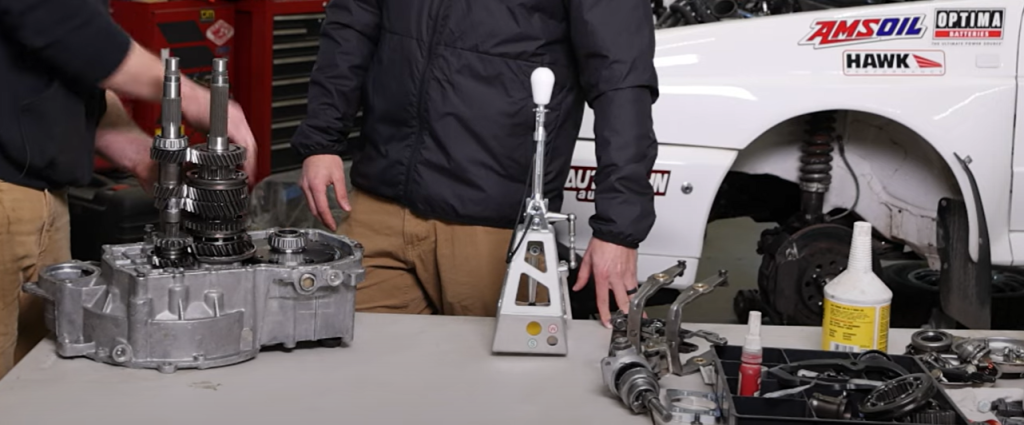The Toyota RAV4 has been a popular compact SUV since its introduction in the 1990s. Known for its reliability and versatility, the RAV4 has gone through several generations of changes. One feature that many driving enthusiasts have appreciated over the years is the manual transmission option.
The last year Toyota offered a manual transmission in the RAV4 was 2005. This coincided with the end of the second generation RAV4 models. After that point, Toyota moved away from manual transmissions in the North American market for this vehicle. The shift reflected changing consumer preferences and the broader industry trend towards automatic transmissions.
For those who enjoy the control and engagement of a manual gearbox, earlier RAV4 models can still be found on the used car market. The first and second generation RAV4s came with 5-speed manual transmissions paired with efficient 4-cylinder engines. These models offer a unique driving experience that combines the practicality of an SUV with the hands-on feel of a manual transmission.
Key Takeaways
- Manual transmissions were available in RAV4 models until 2005
- Early RAV4 generations offered 5-speed manual gearboxes
- Used RAV4s with manual transmissions can still be found for enthusiasts
Toyota RAV4 Overview
The Toyota RAV4 is a popular compact SUV known for its reliability and versatility. It has gone through several generations since its introduction, with changes in design, features, and transmission options.
History and Evolution
Toyota launched the RAV4 in 1994 as one of the first compact crossover SUVs. The name RAV4 stands for “Recreational Active Vehicle with 4-wheel drive.”
The first-generation RAV4 had a 2.0-liter inline-four engine. It was designed to be fuel-efficient and came with a 5-speed manual transmission.
Over the years, the RAV4 grew in size and capabilities. The second generation (2000-2005) offered more engine options and improved interior space.
Later generations brought significant styling changes and advanced safety features. The current RAV4 is in its fifth generation, introduced in 2018.
Manual Transmission Availability
Manual transmissions were once common in the RAV4, but their availability has decreased over time.
Early RAV4 models often came with manual transmission options. This gave drivers more control over gear shifting and fuel efficiency.
Recent RAV4 models in North America no longer offer manual transmissions. The current RAV4 uses an 8-speed automatic transmission paired with a 2.5-liter four-cylinder engine.
Some international markets may still have manual RAV4 options. However, automatic transmissions have become the standard in most regions.
This shift reflects changing consumer preferences and advancements in automatic transmission technology.
Manual Transmission Mechanics

Manual transmissions in Toyota RAV4 models give drivers direct control over gear shifts. They have several key components that work together to transfer power from the engine to the wheels.
Transmission Components
The main parts of a manual transmission include:
- Clutch
- Gearbox
- Shift lever
- Synchronizers
- Input shaft
- Output shaft
- Gears
The clutch connects and disconnects the engine from the transmission. The gearbox houses the gears and shafts. The shift lever allows the driver to select gears. Synchronizers help match gear speeds for smooth shifts.
How Manual Transmissions Work
When the driver presses the clutch pedal, it disengages the engine from the transmission. This allows gear changes without damaging components.

The shift lever moves the selector fork, which engages different gears on the output shaft. Releasing the clutch pedal re-engages the engine and transmission.
Gear ratios determine the relationship between engine speed and wheel speed. Lower gears provide more torque for acceleration, while higher gears are for cruising at speed.
Proper shifting technique involves:
- Press clutch
- Select gear
- Release clutch smoothly
This process transfers power efficiently from the engine to the wheels.
Driving Experience
The manual transmission Toyota RAV4 offers a unique driving experience. It gives drivers more control and engagement with the vehicle’s performance.
Shifting Gears
Shifting gears in a manual RAV4 is smooth and precise. The clutch pedal has a light feel, making it easy to use in stop-and-go traffic. The gear lever moves smoothly between positions, allowing for quick shifts.
Drivers can choose the right gear for each situation. This helps with fuel efficiency and performance. For example, downshifting before a hill climb gives more power. Upshifting on highways reduces engine noise and saves gas.
Manual transmissions let drivers use engine braking. This helps slow the car without using the brakes as much. It’s useful when going downhill or in slippery conditions.
Handling and Control
The manual RAV4 gives drivers a strong connection to the road. They can feel how the car responds to different driving conditions. This enhances the overall driving experience.
Cornering is more precise with a manual transmission. Drivers can select the right gear before entering a turn. This helps maintain the ideal speed and balance through curves.
The manual RAV4 shines in off-road situations. Drivers can control wheel spin by managing the clutch and accelerator. This improves traction on loose or slippery surfaces.
Parking on hills is easier with a manual transmission. The clutch allows for more precise control at very low speeds. This helps when navigating tight spots or steep driveways.
Maintenance and Care
Taking care of a Toyota RAV4 with a manual transmission requires regular checks and prompt attention to issues. Proper maintenance ensures smooth operation and extends the lifespan of the vehicle’s components.
Routine Checks
Regular maintenance is key for a RAV4 with manual transmission. Check the clutch fluid level monthly. Top it up if needed using the correct type specified in the owner’s manual.
Inspect the clutch pedal for proper free play. Adjust if necessary to prevent premature wear. Check the gear oil level every 30,000 miles or as recommended by Toyota.
Examine the shift linkage for looseness or damage. Lubricate as needed to maintain smooth shifting. Look for signs of leaks around the transmission housing.
Test the clutch engagement and release. Listen for unusual noises when shifting gears. These could indicate potential issues.
Common Issues and Solutions
Clutch slippage is a frequent problem in manual transmissions. If the engine revs but the car doesn’t accelerate properly, the clutch may need replacement.
Difficulty shifting gears can stem from low transmission fluid. Check the fluid level and top up if needed. If the problem persists, the clutch master cylinder might require attention.
A grinding noise when shifting could indicate worn synchronizers. This often requires professional repair. A loose or worn shift linkage can cause imprecise gear changes. Tightening or replacing the linkage usually solves this issue.
Strange noises or vibrations may point to worn bearings or gears. Prompt attention from a qualified mechanic can prevent more extensive damage.
Customization and Upgrades
The Toyota RAV4 offers many options for customization and upgrades. Owners can enhance both performance and aesthetics to tailor their vehicle to their preferences.
Performance Parts
Performance upgrades can boost the RAV4’s capabilities. Cold air intakes improve engine airflow and power. Aftermarket exhaust systems may increase horsepower and give a sportier sound.
Suspension upgrades like coilovers or lift kits can improve handling or off-road ability. Larger wheels and tires offer better traction and ground clearance.
For towing, trailer hitches increase utility. Some hitches can handle up to 3,500 pounds of gross trailer weight.
Performance chips or tuners can optimize engine settings for more power or better fuel economy. Upgraded brake pads and rotors improve stopping power for enhanced safety.
Aesthetic Modifications
Visual upgrades let RAV4 owners personalize their vehicle’s look. Black chrome exhaust tips add a sleek touch to the rear. Aftermarket grilles can give the front end a bolder appearance.
Window tinting enhances privacy and reduces interior heat. LED lighting upgrades, including headlights and fog lights, improve visibility and style.
Interior mods like custom seat covers or steering wheel wraps add comfort and flair. Roof racks or cargo boxes increase storage options while changing the RAV4’s profile.
Paint protection films or ceramic coatings preserve the vehicle’s finish. Vinyl wraps allow for dramatic color changes or unique patterns without permanent alterations.
Frequently Asked Questions
Toyota RAV4 manual transmissions have specific issues, availability, and performance characteristics. Some models offer different manual transmission options with varying specifications.
What are common issues with the Toyota RAV4 manual transmission?
Toyota RAV4 manual transmissions can experience gear shifting problems. This may include difficulty engaging gears or a grinding noise when shifting.
Clutch wear is another common issue. It can lead to slipping or a heavy clutch pedal feel.
How can one find a Toyota RAV4 with a manual transmission for sale?
Finding a RAV4 with manual transmission requires searching older models. Check used car listings on websites and local dealerships.
Contacting Toyota enthusiast groups or forums can help locate manual transmission RAV4s for sale.
What are the specifications of the manual transmission in a Toyota RAV4?
The first-generation RAV4 came with a 5-speed manual transmission. It was paired with a 2.0-liter inline-four engine.
Later models offered 6-speed manual transmissions in some regions. These provided smoother shifting and improved fuel efficiency.
Until what year was the manual transmission available in the Toyota RAV4?
Manual transmissions were available in early RAV4 generations. The second-generation RAV4 (2000-2005) still offered manual options.
Availability varied by region. In some markets, manual transmissions were phased out earlier than others.
Are there differences in performance between the 6-speed and other manual transmissions in Toyota RAV4?
The 6-speed manual transmission offers more precise gear ratios. This can lead to better acceleration and fuel economy compared to earlier 5-speed models.
6-speed transmissions often provide a more relaxed engine speed at highway cruising speeds.
What is involved in the process of replacing the manual transmission in a Toyota RAV4?
Replacing a RAV4 manual transmission involves removing the old unit. This requires disconnecting the driveshaft and other components.
The new transmission must be properly aligned and connected. Clutch components are typically replaced during this process.


